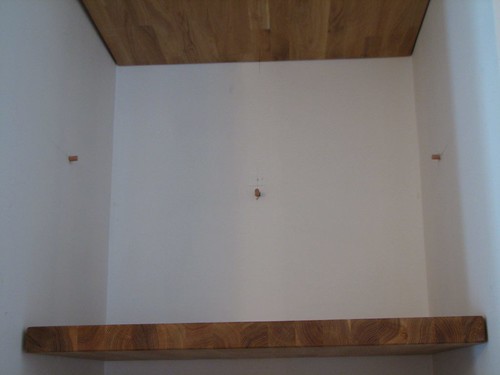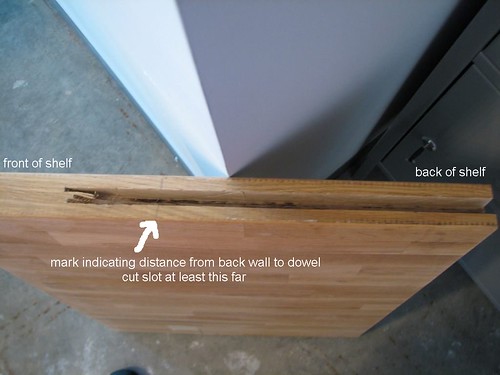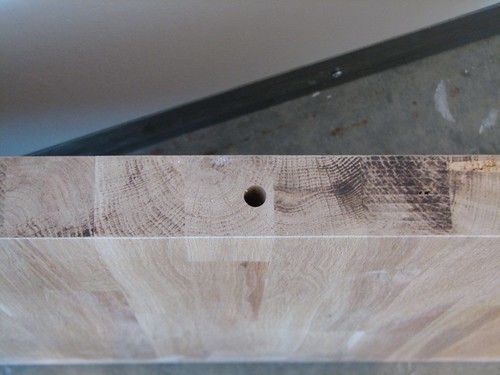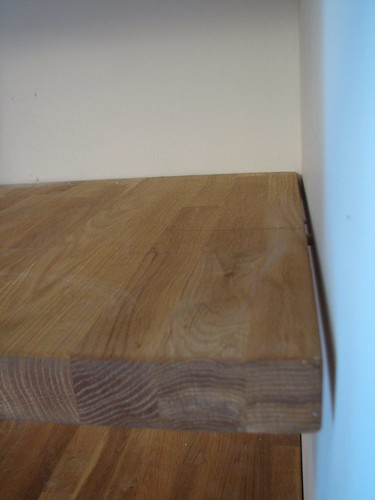Floating Shelves in the Closet
Back to the guest bathroom, where the tall IKEA PS cabinet that matches the one in this post, also in the guest bathroom, just happened to be an exact fit for the closet nook:

I love happy accidents!
I wanted to continue the wood theme over from the vanity, and since this is a closet I figured why not use the same NUMERAR oak butcherblock to make shelves? It was quick and easy enough to cut up into shelf-sized chunks, but I wanted them to be floating, because I've never met a shelf bracket I got along with. Acheiving that required a little domestic engineering, and with the help of Boy, here's how we got float:
First I located the studs in the walls of the nook. In my case, the closet only had three, one in the back wall and one on either side. I marked their location carefully and drew a vertical line that extended up at least to where I thought I wanted my uppermost shelf. Then I figured out how high I wanted each of the shelves and used a level to carefully draw a level line all the way around on the three walls.
Next I cut pieces of 3/8" oak dowel, 2 1/2" or so in length. In my case I needed three for each shelf because there are three studs. Using the level line I just drew and the previously marked studs, I drilled a 3/8" hole through the sheetrock and into each stud about an inch or inch and a half, being careful to drill straight and level. Then I pounded one of the pieces of dowel into each of the holes:

The dowel is now snug in the stud and is sticking out from the drywall about an inch. (I could have glued them in just in case.) After the dowels were all in place, I measured the distance from the back of the nook to the dowel and marked this distance on the piece of butcherblock that will become the shelf.
Using a table saw (a circular saw would probably be easier), I cut a slot into either side of the butcherblock. It took several passes through the saw to achieve the necessary width, and what I was looking for was a channel just slightly wider than 3/8", centered within the thickness of the wood and extending along the edge of the shelf just a bit farther than the distance from the back of the nook to the dowels on either side:

In my case, the dowel pegs stuck out from the wall about an inch, so I set the depth of the saw blade to cut slightly deeper than this, maybe 1 1/4".
Using the same 3/8" drill bit I used on the walls, I drilled a hole in the back edge of the shelf that exactly matched up with the location of the dowel peg sticking out of the back wall:

The shelves just slid right into place, with the side dowels slotting into the saw cut channel. The pin on the back wall fit into the hole drilled in the back of the shelf to keep everything nice and snug. I didn't glue any of it because my shelves won't be seeing a lot of activity but it probably wouldn't hurt.
Below you can see the shelf in place and the dowel that's holding it up there peeking out of the gap:

Now for some paint and accessories!

I love happy accidents!
I wanted to continue the wood theme over from the vanity, and since this is a closet I figured why not use the same NUMERAR oak butcherblock to make shelves? It was quick and easy enough to cut up into shelf-sized chunks, but I wanted them to be floating, because I've never met a shelf bracket I got along with. Acheiving that required a little domestic engineering, and with the help of Boy, here's how we got float:
First I located the studs in the walls of the nook. In my case, the closet only had three, one in the back wall and one on either side. I marked their location carefully and drew a vertical line that extended up at least to where I thought I wanted my uppermost shelf. Then I figured out how high I wanted each of the shelves and used a level to carefully draw a level line all the way around on the three walls.
Next I cut pieces of 3/8" oak dowel, 2 1/2" or so in length. In my case I needed three for each shelf because there are three studs. Using the level line I just drew and the previously marked studs, I drilled a 3/8" hole through the sheetrock and into each stud about an inch or inch and a half, being careful to drill straight and level. Then I pounded one of the pieces of dowel into each of the holes:

The dowel is now snug in the stud and is sticking out from the drywall about an inch. (I could have glued them in just in case.) After the dowels were all in place, I measured the distance from the back of the nook to the dowel and marked this distance on the piece of butcherblock that will become the shelf.
Using a table saw (a circular saw would probably be easier), I cut a slot into either side of the butcherblock. It took several passes through the saw to achieve the necessary width, and what I was looking for was a channel just slightly wider than 3/8", centered within the thickness of the wood and extending along the edge of the shelf just a bit farther than the distance from the back of the nook to the dowels on either side:

In my case, the dowel pegs stuck out from the wall about an inch, so I set the depth of the saw blade to cut slightly deeper than this, maybe 1 1/4".
Using the same 3/8" drill bit I used on the walls, I drilled a hole in the back edge of the shelf that exactly matched up with the location of the dowel peg sticking out of the back wall:

The shelves just slid right into place, with the side dowels slotting into the saw cut channel. The pin on the back wall fit into the hole drilled in the back of the shelf to keep everything nice and snug. I didn't glue any of it because my shelves won't be seeing a lot of activity but it probably wouldn't hurt.
Below you can see the shelf in place and the dowel that's holding it up there peeking out of the gap:

Now for some paint and accessories!


3 Comments:
very nicely done...I always love floating shelves but this is a far more elegant way to do it.
big fan of all you've done ! this particular post solves a problem I've been been stressing over for a couple of days-
thanks again
¡Genial!
Post a Comment
<< Home